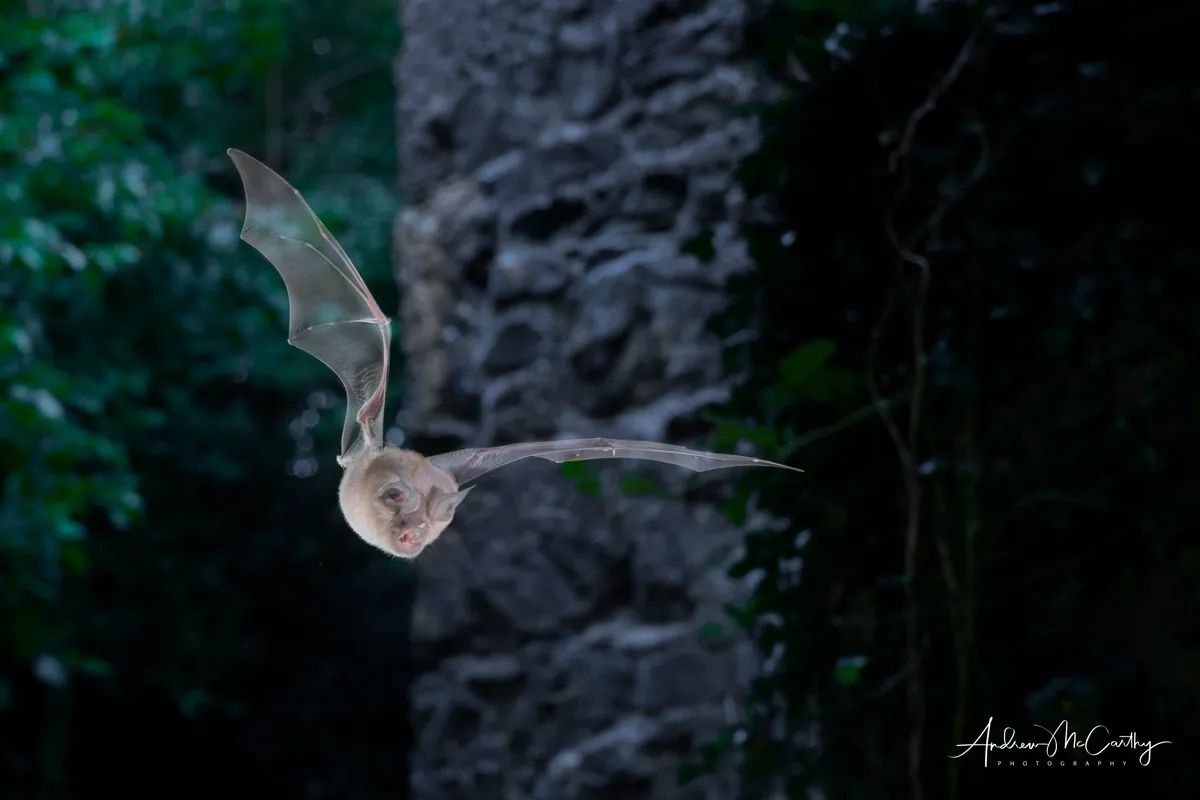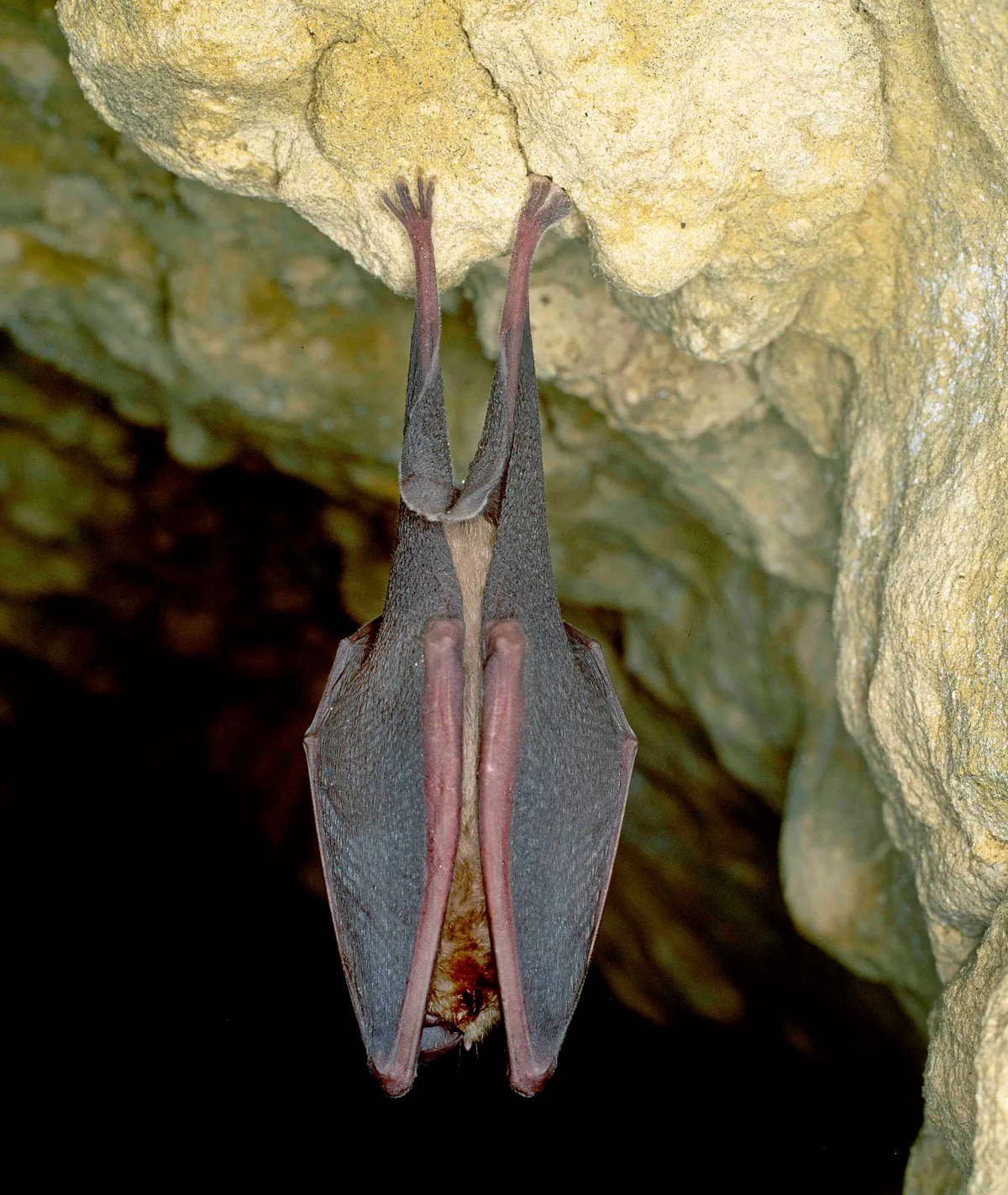Globally, there are over 85 species of horseshoe bats, but only two species are native to the British Isles: the greater horseshoe bat and the lesser horseshoe bat. Named for the distinctive circular flap of skin that surrounds their nostrils, these bat species suffered a dramatic population decline during the 20th century.
But although they remain rare in the UK, there is reason to be cautiously optimistic for the future of the greater and lesser horseshoe bats, as their numbers are now gradually increasing.
Find out more about these elusive mammals in our expert guide by the Vincent Wildlife Trust.
What are the scientific names of the horseshoe bats?
The scientific name of the greater horseshoe bat is Rhinolophus ferrumequinum, and the lesser horseshoe bat's scientific name is Rhinolophus hipposideros.
How do horseshoe bats differ from other bats found in Britain?
Horseshoe bats, with their peculiarly shaped nose-leaf, have faces that differ from the other 15 bat species in Britain. This nose-leaf allows them a distinctive method of echolocation. Unlike our other bats, horseshoe bats cloak their wings around their body while asleep and usually hang free by their feet. Other British bat species are able to crawl into crevices if they choose to, but horseshoes do not have the skeletal design for this option.
In appearance, our two horseshoe species are remarkably similar to each other, but the greater horseshoe easily wins on size. It is in fact one of our largest bats, weighing up to 34g. The lesser horseshoe bat is about a third of the size of a greater horseshoe and is one of our smallest bats, weighing no more than 9g. Its body would fit comfortably on a teaspoon.
What is the geographical distribution of horseshoe bats?
In Britain, the greater horseshoe bat is found in parts of southern England and Wales. Its core area today is south-west England and south and west Wales, but it once occurred as far east as Kent.
The lesser horseshoe bat was once distributed across southern England and as far north as Yorkshire. Today, this species is found only in south-west England, the West Midlands and Wales. Unlike the greater horseshoe bat, the lesser horseshoe bat is also found in Ireland but confined to the west coast.
Globally, greater horseshoe bats are found from North Africa across Europe and as far east as Japan. Lesser horseshoes have a more limited range largely across areas of Europe, North Africa and the Middle East.

What is the current population size of horseshoe bats and why did they decline?
The greater horseshoe bat is one of our rarest bat species. It declined in number considerably throughout Europe during the last century – more than 90% in Britain by some estimates. Although still very low, the population is now on the rise and in fact the species is increasing faster in number than any other British bat currently monitored. Estimates put the population size at 13,000 (for comparison, there are around three million pipistrelles).
The lesser horseshoe bat also suffered a widespread and catastrophic decline during the 20th century but is also now showing signs of recovery. Against this background, the lesser horseshoe populations in Britain and Ireland are now internationally important. Estimates put the British population at around 50,000.
The devastating decline in Britain’s bat populations in the 20th century was predominately the result of changes in agricultural practices, including a greater use of pesticides, as well as the use of toxic timber treatment chemicals in the building industry.
All British bat species are now protected under the 1981 Wildlife and Countryside Act, but many threats remain, including food availability, suitable roost sites, habitat fragmentation and other anthropogenic factors such as traffic noise and light pollution.
What do horseshoe bats eat?
Like all British bats, horseshoe bats feed on insects.
Greater horseshoe bats prefer moths and larger beetles, including dung beetles and cockchafers. In spring, they feed over cattle-grazed pasture and in ancient semi-natural woodland. During the summer, they forage over hay meadows and silage fields. On some nights they may travel up to 12km in search of food. They hunt their prey by flying low and even picking insects off the ground. Sometimes the bats will hang from branches and use their sonar to scan for passing insects to pursue and bring back to consume at the perch.
Lesser horseshoe bats feed on small flying insects such as midges, but they also take crane flies, moths and caddisflies. On leaving their roost, the bats fly low to the ground or hug the walls of buildings as they head for the nearest vegetative cover. They fly to deciduous woodland, usually within two kilometres of their roost, following hedgerows and treelines. Here, they hunt in or below the tree canopy, catching their prey in flight or picking items from foliage. Occasionally this species, like the greater horseshoe bat, takes prey from the ground and sometimes hunts from a perch.
How do horseshoe bats find their food?
Horseshoe bats have a distinctive method of echolocation, shouting through their nostrils rather than their mouths as do most other British bats. The horseshoes use very high frequency sounds emitted through their distinctive horseshoe-shaped nose-leaf. The disc of flesh around the nostrils, and the folds in the nose-leaf, channel and direct narrow beams of ultrasound into their environment. The returning echoes allow the bats to detect obstacles in the darkness and the speed and trajectory of their prey.
Where do horseshoe bats live?
Historically, horseshoe bats roosted throughout the year in caves, and underground sites remain important as roosts for these bats, especially during the winter. During the summer, a few horseshoe bat maternity colonies roost underground but the majority use buildings.
Horseshoe bats are very selective in the type of buildings they use, preferring old stone-walled buildings with slate roofs and are often associated with country estates, churches, disused cottages and farm outbuildings. The bats prefer large entrances that allow uninterrupted flight into roosting areas that are usually in roof spaces, attics or sometimes in cellars. The colonies are very visible, hanging freely from ceilings, rafters or ridge beams. Unlike many British species, horseshoe bats do not hide in cracks or crevices.
No roosts of these two species have been found in modern houses, perhaps because of the lack of suitably large entrances and roof spaces. They may, however, colonise purpose-built bat houses.
During winter, horseshoe bats hibernate in underground sites such as caves, disused mines, ice houses or unheated cellars. They may also use unheated buildings during periods of mild weather.
Unlike greater horseshoe bats, the lesser horseshoe never clusters in hibernation. Where large numbers occur in a site, each bat remains slightly apart from its neighbour.

When do horseshoe bats breed?
Towards the end of April, females congregate to form maternity colonies, clustering together in cooler weather to maintain a high body temperature. The pregnant females will each give birth to a single baby, known as a pup, usually from late June through to early July for lesser horseshoes and to late July for greater horseshoes. Spring temperatures determine the peak birth period. Infant mortality can be very high, especially if weather conditions are poor during late pregnancy.
In the first few days a pup may be carried from the roost by its mother when she goes out at night to hunt, but then the young are left in a cluster in the roost while the mothers fly out to feed. The young are fully weaned at about seven weeks, after which the females may disperse from the roost leaving the juveniles to occupy the site until late September to October, when they move on to hibernation sites.
Are there any concerns for horseshoe bats?
Population growth and range expansion of both species is limited by a number of factors. This species’ dependence on maternity roosting sites that are both scarce and under threat from disturbance or development does give cause for concern. Any range expansion is also limited by the availability of suitable hibernation sites.
Roost protection by organisations such as Vincent Wildlife Trust (VWT) has played a critical role in reversing the fortunes of these species. The VWT now manages the roost sites of around 50% of Britain’s greater horseshoe bats.
It is also important, however, to focus on the wider environment. Conservation organisations like VWT are working hard to ensure the resilience of landscapes surrounding the bats’ roosts – the bats’ flyways and foraging areas. After all, it is no good living in a luxury hotel if the restaurant has run out of food.
Research has also shown the negative impact on bats, including horseshoe bats, of artificial street lighting (horseshoe bats are particularly light shy) and this, together with noise pollution from road traffic, can inhibit foraging activity.
Quite how climate change will impact horseshoe bats is uncertain. Although they are showing signs of range and population expansion, which is good news, and have benefited from milder winters, they can be negatively impacted by extreme weather events, especially severe winters and cold springs. With a low reproductive rate, they are not a species that will recover easily from a population crash.
Close monitoring of horseshoe bat colonies, by VWT and other conservation bodies, will give early warning of any signs that the current population recovery is faltering. At the moment, however, it is looking positive for horseshoe bats in Britain and Ireland.
Vincent Wildlife Trust is a wildlife charity focusing on mammal research and conservation in Britain and Ireland. Increasingly, the Trust also works in mainland Europe.





